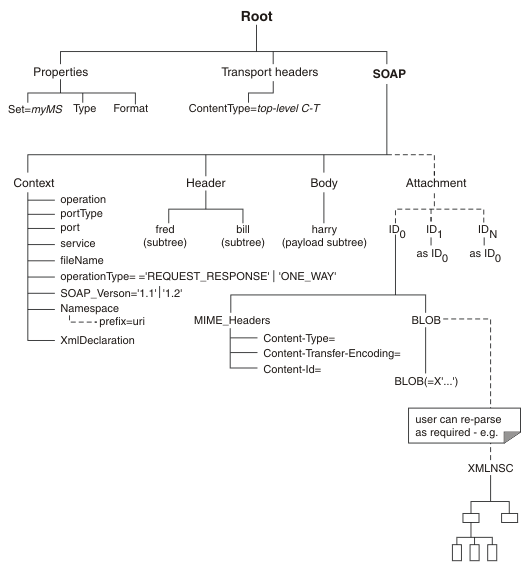SOAP tree overview
This tree format allows you to access the key parts of the SOAP message in a convenient way.
This is a diagrammatic representation of the SOAP domain tree:

SOAP.Header- Contains the SOAP header blocks (children of
Envelope.Header) SOAP.Body- Contains the SOAP payload (children of
Envelope.Body)The content of the
Bodysubtree depends on the WSDL style. SOAP.Attachment- Contains attachments for an
SwAmessage in their non encoded format.Note that attachments for an
MTOMmessage are represented inline as part of the SOAP content in a base 64 representation. SOAP.Context- Contains the following information:
- Input; populated by the SOAPInput node:
operation- the WSDL operation name. In Gateway mode, the operation is assumed to be the name of the element that is the first child of the SOAP Body element, if present, otherwise it is the constant name 'ComIbmBrokerGenericGatewayOperation'.portType- the WSDL port type name. In Gateway mode, this item is empty.port- the WSDL port name (if known). In Gateway mode, this item is empty.service- the WSDL service name (if known). In Gateway mode, the service has the constant name 'ComIbmBrokerGenericGatewayService'.fileName- the original WSDL file name. In Gateway mode, this item is empty.operationType- one of 'REQUEST_RESPONSE', 'ONE_WAY', 'SOLICIT_RESPONSE', 'NOTIFICATION'. In Gateway mode, without WSDL, this field contains 'GATEWAY'. This means 'REQUEST_RESPONSE' or 'GATEWAY_ONE_WAY', which means that the node has detected the operation type to be one-way.SOAP_Version- one of '1.1' or '1.2'.Namespace- ContainsnameValuechild elements; thenameis the Namespace prefix, and thevalueis the Namespace URI as it appears in the bit stream.XmlDeclaration- represents the standard XML declaration.
- Output; the following fields can be placed in
SOAP.Contextto provide override information when SOAPRequest or SOAPAsyncRequest nodes serialize a SOAP message:SOAP_Version- one of '1.1' or '1.2'Namespace- ContainsnameValuechild elements that define the namespace prefix (thename) to be used for a specified namespace URI (thevalue).An output message uses the namespace prefixes defined here to qualify any elements in the corresponding namespaces.
If the
SOAP.Contextwas originally created at an input node, it might already contain all the namespace prefix definitions that you need.If
SOAP.Contextdoes not exist, or the outgoing message uses additional namespaces, the SOAP parser generates any required namespace prefixes automatically.Alternatively, you can specify your own namespace prefix; the specific name of a namespace prefix does not usually affect the meaning of a message, with one important exception. If the message content contains a
qualified name, the message must contain a matching namespace prefix definition.For example, if the output message is a SOAP Fault containing a <faultcode> element with the valuesoapenv:Server, a namespace prefix (which is case sensitive) forsoapenvmust be defined in the logical tree:-- Build SOAP Fault message. Note that as well as defining the correct -- namespace for the Fault element, it is also necessary to bind the -- namespace prefix used in the faultcode element (this is set up under -- SOAP.Context.Namespace) -- Send back a new user defined SOAP 1.2 fault message DECLARE soapenv NAMESPACE 'http://www.w3.org/2003/05/soap-envelope'; DECLARE xml NAMESPACE 'http://www.w3.org/XML/1998/namespace'; DECLARE myNS NAMESPACE 'http://myNS'; SET OutputRoot.SOAP.Context.Namespace.(SOAP.NamespaceDecl)xmlns:soapenv = soapenv; SET OutputRoot.SOAP.Context.Namespace.(SOAP.NamespaceDecl)xmlns:myNS = myNS; SET OutputRoot.SOAP.Body.soapenv:Fault.soapenv:Code.soapenv:Value = 'soapenv:Receiver'; SET OutputRoot.SOAP.Body.soapenv:Fault.soapenv:Code.soapenv:Subcode.soapenv:Value = 'my:subcode value'; SET OutputRoot.SOAP.Body.soapenv:Fault.soapenv:Reason.soapenv:Text = 'my Reason string'; SET OutputRoot.SOAP.Body.soapenv:Fault.soapenv:Reason.soapenv:Text.(SOAP.Attribute)xml:lang = 'en'; SET OutputRoot.SOAP.Body.soapenv:Fault.soapenv:Node = 'my Node string'; SET OutputRoot.SOAP.Body.soapenv:Fault.soapenv:Role = 'my Role string'; SET OutputRoot.SOAP.Body.soapenv:Fault.soapenv:Detail.my:Text = 'my detail string';-- Send back a new user defined SOAP 1.1 fault message DECLARE soapenv NAMESPACE 'http://schemas.xmlsoap.org/soap/envelope/'; SET OutputRoot.SOAP.Context.Namespace.(SOAP.NamespaceDecl)xmlns:soapenv = soapenv; SET OutputRoot.SOAP.Body.soapenv:Fault.faultcode = 'soapenv:Receiver'; SET OutputRoot.SOAP.Body.soapenv:Fault.faultstring = 'my fault string'; SET OutputRoot.SOAP.Body.soapenv:Fault.faultactor = 'my fault actor'; SET OutputRoot.SOAP.Body.soapenv:Fault.detail.Text = 'my detail string';
- Input; populated by the SOAPInput node:
Namespace, SOAP_Version,
and XmlDeclaration influence the bit stream generated
for a SOAP tree; the other fields are for information only.To build a graphical data map for the SOAP domain, use the supplied IBM® message for the SOAP domain tree as the input for the map, the output, or both. Use the Cast or Submap features of the Graphical Data Mapper to define the specific content of the SOAP body. See Using message maps for more information about mapping functions.